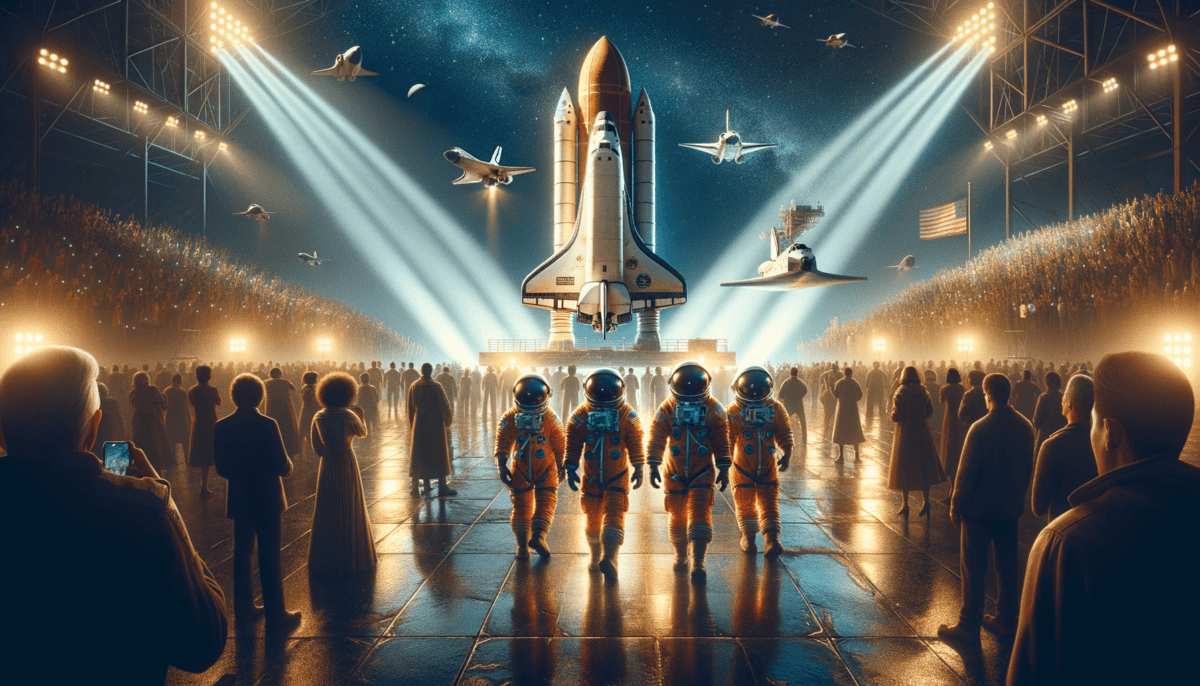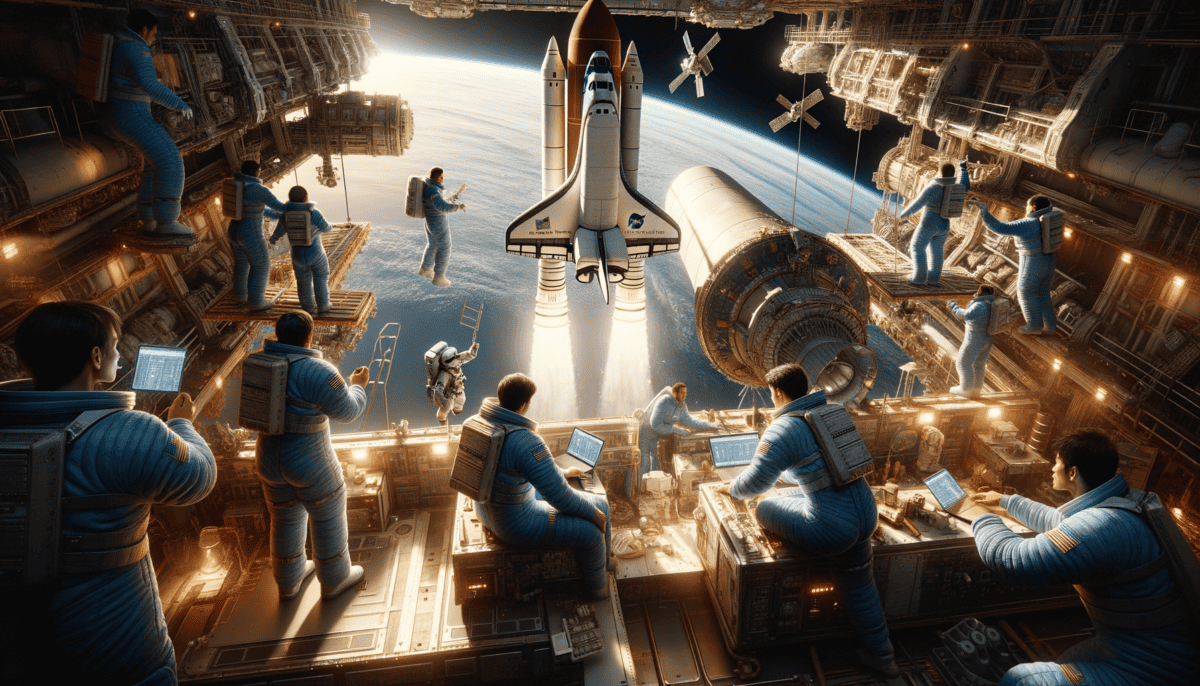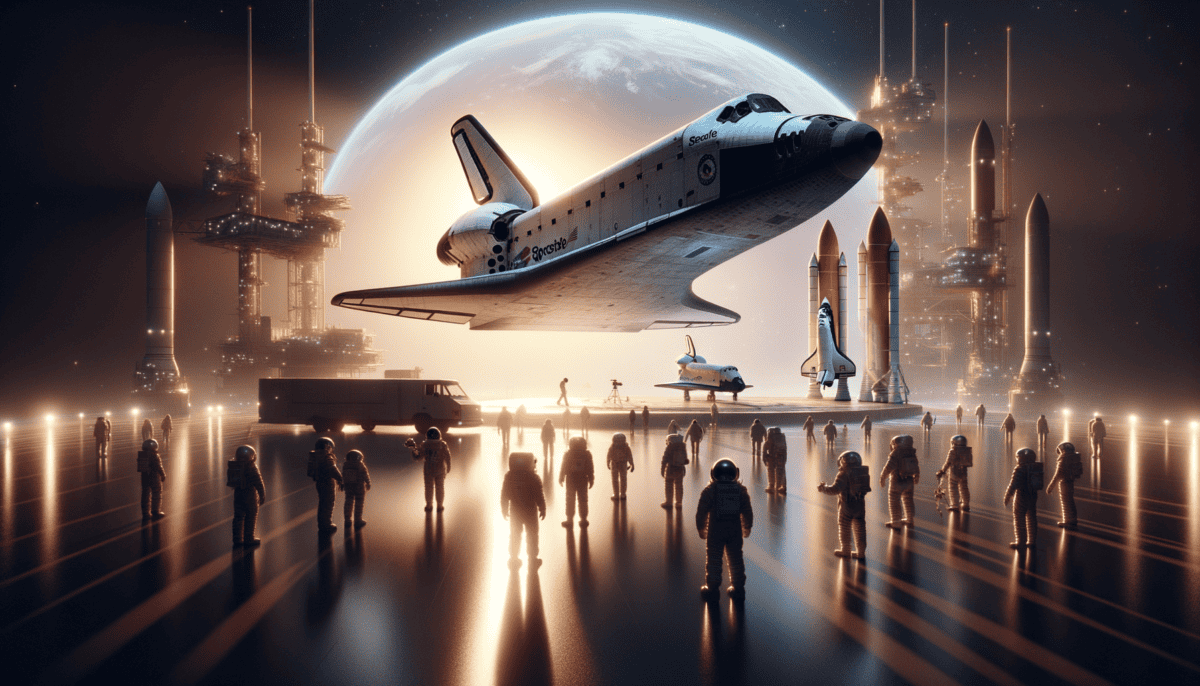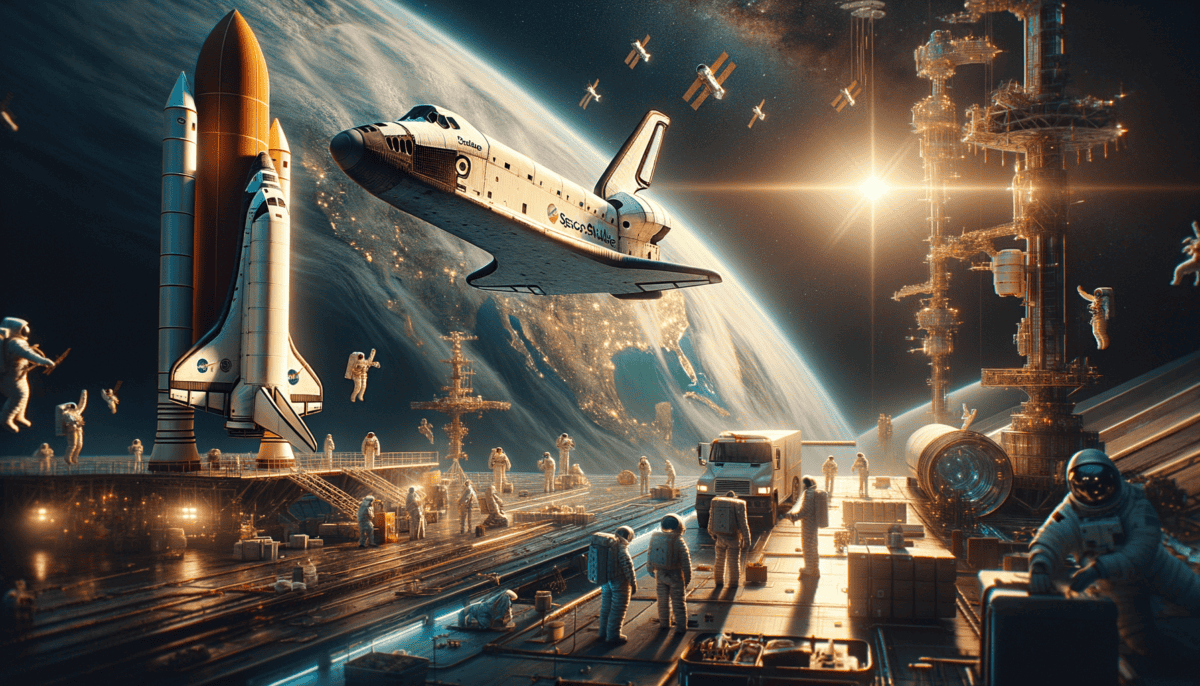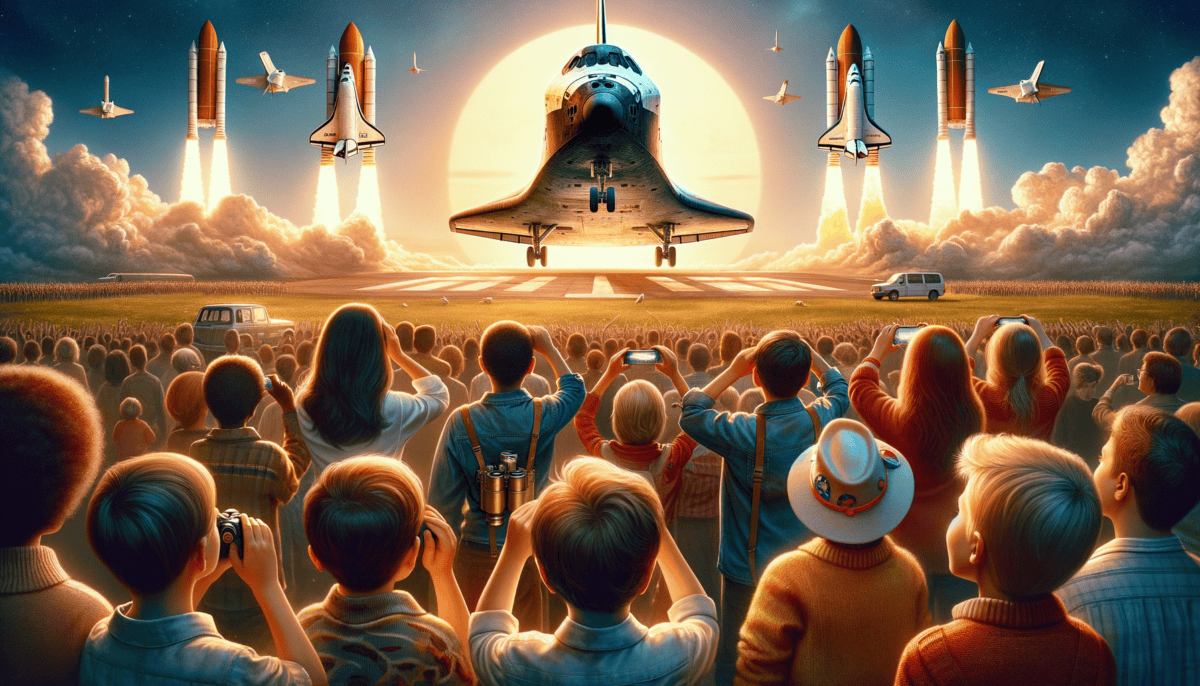Dreams Taking Flight
On a bright morning in 1972, a group of NASA scientists gathered around a big table. They had a dream – to build a spaceship that could fly to space again and again, just like an airplane! This was the beginning of the Space Shuttle story.
Dr. Max Faget, one of NASA’s smartest engineers, drew the first pictures of what would become the Space Shuttle. He imagined a spacecraft that looked different from anything before. It had wings like an airplane but could zoom into space like a rocket!
“We need to make it safe and strong,” Dr. Faget told his team. “And it needs to come back home like a gentle bird.”
Building the Dream
Making this new kind of spaceship wasn’t easy. The team had to solve lots of tricky problems:
- How to protect it from super-hot temperatures when coming back to Earth
- How to make wings that work both in space and in the air
- How to build engines strong enough to reach space
- How to land it safely on a runway
Did you know? The Space Shuttle needed special tiles to keep it from getting too hot. These tiles were so special they could be red-hot on one side but cool enough to hold in your hand on the other!
“We’re not just building a spaceship,” said John Young, an astronaut who would later fly the first shuttle. “We’re building the future.”
A New Kind of Space Travel
The team worked hard for many years. They built test models and tried new ideas. Sometimes things didn’t work, but they never gave up. They knew this new spaceship would change how we explore space forever.
By 1976, something amazing appeared in the California desert. It wasn’t a bird, and it wasn’t quite a plane – it was the first Space Shuttle, named Enterprise!
Scientists tested Enterprise by dropping it from a big airplane. They needed to make sure it could glide and land safely. Each test brought them closer to their dream of a reusable spaceship.
Getting Ready for Space
As the tests went on, excitement grew. Everyone from kids to grown-ups watched as this new kind of spacecraft took shape. It would be bigger than any spaceship before it, with room for seven astronauts and a cargo bay as big as a school bus!
The team gave special names to the first Space Shuttles they built:
| Columbia | The first one to fly in space |
| Challenger | Named after a ship that explored the ocean |
| Discovery | Ready to discover new things in space |
As the sun set on the 1970s, the Space Shuttle was almost ready for its first big journey. The dream of a reusable spaceship was about to come true. Scientists, engineers, and astronauts worked together to make something that had never been done before.
Columbia Rises – The First Mission
The morning of April 12, 1981, was special. The Space Shuttle Columbia sat on the launch pad, gleaming in the early sunlight. Two brave astronauts, John Young and Bob Crippen, were about to make history!
John Young was like a space superhero. He had already been to space four times! But for Bob Crippen, this would be his very first space trip. Both men had trained for years for this big day.
Getting Ready for Launch
“Are you nervous?” someone asked Bob Crippen. He smiled and said, “Not nervous – excited! We’ve practiced this thousands of times.”
The countdown began. Hundreds of people worked in the control room, checking everything twice. They wanted to make sure Columbia was ready to fly safely.
“The Space Shuttle is ready. The crew is ready. Let’s roll!” – Launch Director
The Big Moment
At 7:00 in the morning, the countdown reached zero. WHOOSH! Fire and smoke burst from Columbia’s engines. The ground shook like a thousand drums beating at once.
Up, up, up went Columbia! Thousands of people watched from the ground. They cheered and some even cried happy tears. This was different from any launch before – this spaceship would come back to fly again!
Flying in Space
For two days, Young and Crippen flew Columbia around Earth. They tested everything to make sure it worked just right:
- The special doors that opened to space
- The wings that would help them land
- The computers that helped fly the ship
- The tiles that kept them safe from the heat
They took pictures of our beautiful Earth and talked to NASA on the radio. “Columbia is flying perfectly!” they reported. Everyone on the ground was so happy to hear this news.
Coming Home
After 36 trips around Earth, it was time to come home. This would be another big test – no spaceship this big had ever landed like an airplane before!
When the wheels stopped rolling, John Young jumped out and danced around the shuttle. “What a flying machine!” he shouted. Bob Crippen couldn’t stop smiling. They had done it!
| Launch Time | 7:00 AM |
| Days in Space | 2 days |
| Times Around Earth | 36 times |
The first Space Shuttle mission was perfect! It showed everyone that this new kind of spaceship really could work. Columbia had opened the door to a new way of exploring space.
People celebrated all across America. Kids drew pictures of the Space Shuttle in school. Everyone was proud of what NASA had done. This was just the beginning of many amazing space adventures to come!
Breaking Barriers in Space
Space was about to change forever! After Columbia’s first flight, NASA was ready to welcome new kinds of astronauts. They wanted to show that anyone could reach for the stars!
Sally’s Big Dream
In 1983, something amazing happened. Sally Ride became the first American woman to fly in space!
When reporters asked Sally what it felt like to be the first woman in space, she smiled and said, “It feels just right!” She flew on the Space Shuttle Challenger and did important science experiments.
“The stars don’t care if you’re a boy or a girl. Space is for everyone!” – Sally Ride
Mae’s Space Journey
Then came Mae Jemison in 1992! She became the first Black woman to zoom into space. Mae rode on the Space Shuttle Endeavour and showed kids everywhere that their dreams could come true too.
“I saw Star Trek on TV when I was little,” Mae said. “I knew right then I wanted to fly in space!” And she did it!
The Amazing Hubble
In 1990, the Space Shuttle Discovery carried something very special: the Hubble Space Telescope!
Hubble was like a giant camera in space. It could take pictures of stars and planets that were super far away. But at first, Hubble had blurry vision!
- Astronauts had to fly up in the shuttle
- They went on space walks to fix Hubble
- They gave Hubble new “glasses” to see better
- Now it takes the most beautiful space pictures ever!
Friends Around the World
The Space Shuttle helped people from different countries work together in space! Astronauts from Japan, Canada, Europe, and many other places flew on the shuttle.
| First Woman in Space | Sally Ride (1983) |
| First Black Woman in Space | Mae Jemison (1992) |
| Hubble Launch Year | 1990 |
These brave astronauts showed us something important: it doesn’t matter what you look like or where you come from. If you work hard and dream big, you can touch the stars! ⭐
The Space Shuttle helped make space a place for everyone. It carried dreams, hopes, and showed us that the sky is not the limit – it’s just the beginning!
Dark Days and Bright Hope
The Space Shuttle program had many happy days. But sometimes, sad things happen when we try to do big things. NASA faced two very hard days that changed everything.
The Challenger’s Last Flight
On a cold morning in 1986, the Space Shuttle Challenger was ready to fly. Seven brave astronauts were on board, including a teacher named Christa McAuliffe.
But something went wrong. Just 73 seconds after launch, Challenger broke apart in the sky. All seven astronauts were lost.
“We will never forget them as they prepared for their journey and waved goodbye and slipped the surly bonds of Earth to touch the face of God.” – President Reagan
Learning from Sadness
NASA worked very hard to find out what went wrong. They learned that the cold weather had made a part of the rocket too stiff. Like when your toys get cold and don’t work right.
Columbia’s Last Journey
In 2003, another sad day came. The Space Shuttle Columbia was coming home after 16 days in space. But during launch, a piece of foam had hit its wing.
When Columbia tried to come back to Earth, the damage was too big. The shuttle broke apart, and we lost seven more brave astronauts.
| Challenger | January 28, 1986 |
| Columbia | February 1, 2003 |
Getting Back Up Again
These were very sad times for NASA and everyone who loves space. But they didn’t give up!
- NASA made shuttles safer
- They fixed problems they found
- They trained astronauts better
- They never stopped reaching for the stars
Remembering Our Heroes
Today, we remember the brave astronauts who gave their lives for space exploration. Their families started special schools and science centers to help kids learn about space.
The astronauts’ families said something beautiful: “Our loved ones didn’t just fly to space – they helped build a path for others to follow.”
Even when things get hard, space explorers keep going. They know that doing big things means taking big risks. But they also know that the stars are worth reaching for! ⭐
Dreams Among the Stars
After the sad days, NASA had a big dream. They wanted to build a house in space! This house would be called the International Space Station, or ISS for short.
A Home Above Earth
The Space Shuttle became like a space moving truck. It carried big pieces of the ISS up to space, one trip at a time. ️
Astronauts from many countries worked together like a big space family. They came from America, Russia, Japan, Canada, and Europe. They spoke different languages but shared the same dream!
Living in Space
Life on the ISS is very different from Earth. Everything floats! Astronauts have to strap themselves down to sleep, or they might drift away.
“It’s like having a sleepover party in the sky every night!” – Astronaut Sunita Williams
The astronauts do lots of cool science experiments:
- Growing plants without gravity
- Making medicine in space
- Watching how fire burns
- Learning how their bodies change in space
Space Science Magic
The ISS is like a giant science lab floating in space. Scientists learned many new things that help us on Earth:
Sometimes astronauts would go on space walks to fix things outside the station. They looked like tiny spacesuits floating in the big black sky.
A Day in Space Life
| Morning | Exercise to stay strong |
| Afternoon | Do science experiments |
| Evening | Take pictures of Earth |
Working Together
The best part about the ISS was how it brought people together. Countries that sometimes didn’t get along on Earth worked as friends in space!
Every time a Space Shuttle visited the ISS, it brought new friends, fresh food, and more science equipment. It was like getting a special delivery in space!
The Space Shuttle helped build something amazing – a place where humans could live and work in space. It showed us that when we dream big and work together, we can do anything! ⭐
From up there, astronauts could see our whole planet. They said it made them feel like all people on Earth are one big family. And that’s pretty special!
A New Chapter in Space
July 21, 2011, was a special day. The Space Shuttle Atlantis landed for the very last time. It was like saying goodbye to an old friend who had flown 135 missions over 30 years.
The Last Landing
Commander Chris Ferguson brought Atlantis home in the early morning. Stars were still twinkling in the sky. Thousands of people came to watch and cheer!
Looking Back at Amazing Things
The Space Shuttle did so many cool things:
- Flew 135 missions into space
- Carried 355 different astronauts
- Built the International Space Station
- Fixed the Hubble Space Telescope
- Inspired millions of kids to dream big
The Space Shuttle wasn’t just a spaceship. It was like a magical school bus that taught us about space!
New Space Friends
Now, new rocket ships are taking astronauts to space. Companies like SpaceX and Blue Origin are building their own spaceships!
“The Space Shuttle showed us the way. Now it’s time for new adventures!” – NASA Astronaut Karen Nyberg
| Old Space | New Space |
| Space Shuttle | SpaceX Dragon |
| Only NASA | Many Companies |
Dreams Keep Growing
Even though the Space Shuttle doesn’t fly anymore, its spirit lives on! Now people dream about:
– Going back to the Moon
– Flying to Mars
– Building space hotels
– Finding new worlds
The best part? Kids who watched the Space Shuttle are now grown-ups helping build new spaceships! Some might even become astronauts themselves.
A Forever Hero
The Space Shuttle taught us important lessons:
“Dream big, work hard, and never give up – even when things get tough!”
Today, you can visit Space Shuttles in museums. They remind us that anything is possible when we work together and reach for the stars! ⭐
Every time we look up at the night sky, we can remember the brave Space Shuttle and all the amazing things it did. And maybe, just maybe, you’ll be part of the next big space adventure!


